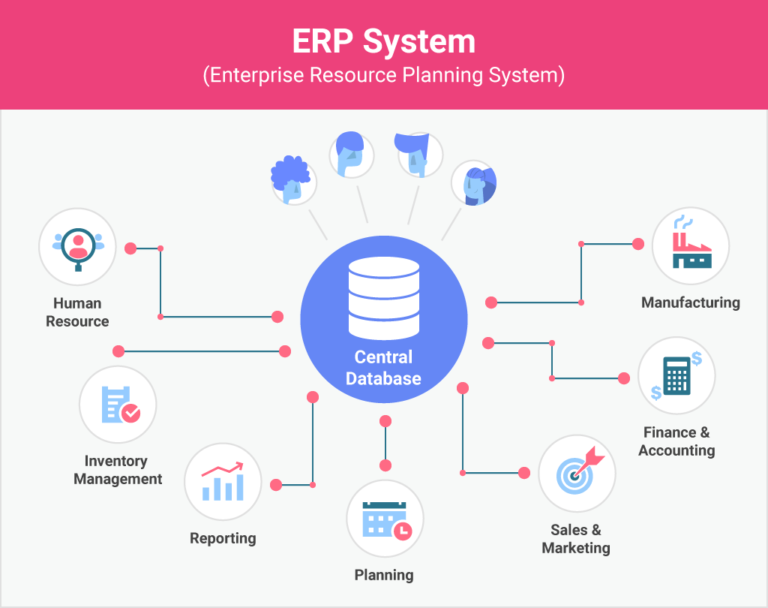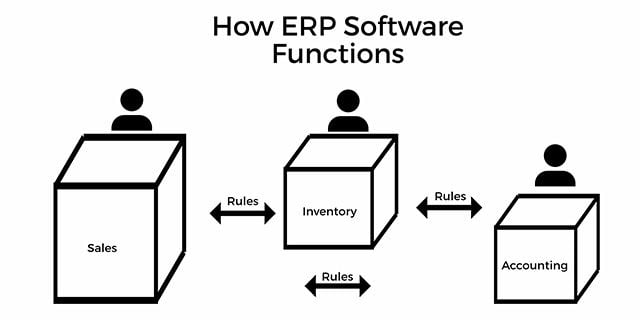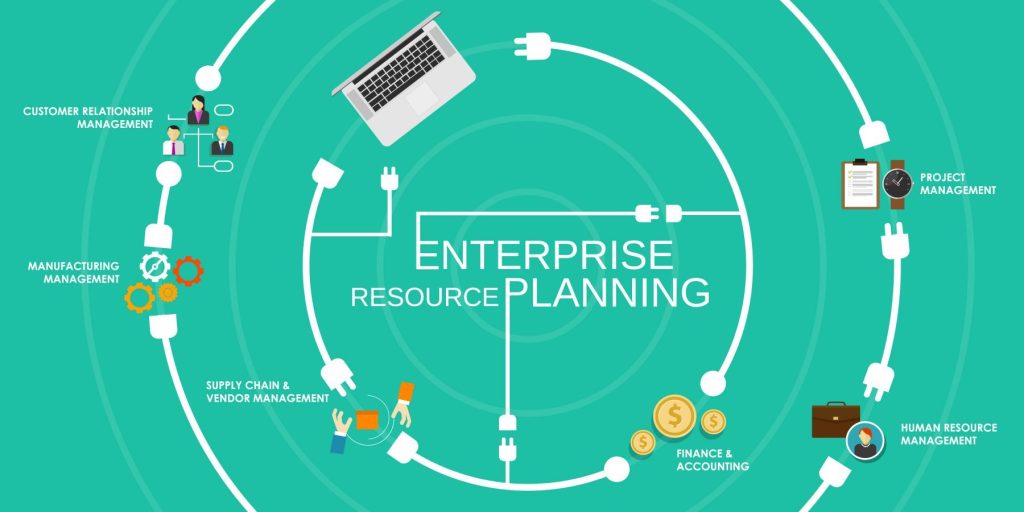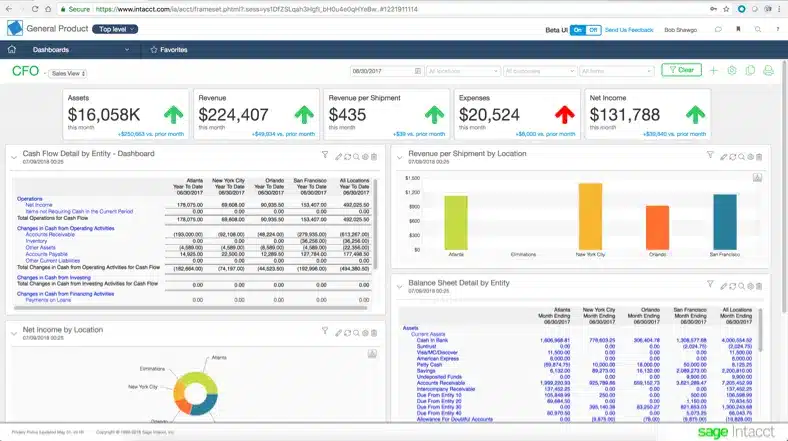ERP accounting software integrates various business processes. It manages finance, inventory, and human resources efficiently.
Understanding how ERP accounting software works can transform business operations. This software automates and streamlines financial tasks. It consolidates data from different departments into one system. This centralization enhances accuracy and reduces errors. ERP systems offer real-time insights, aiding in quick decision-making.
They handle tasks like payroll, budgeting, and invoicing effortlessly. Moreover, these systems ensure compliance with financial regulations. Businesses of all sizes benefit from its scalability. With ERP software, companies can manage resources more effectively. It supports growth by adapting to changing needs. This blog will delve into how ERP accounting software works and its benefits. Stay tuned to explore its features and functionalities.

Credit: www.revealbi.io
Introduction To Erp Accounting Software
Enterprise Resource Planning (ERP) accounting software combines business processes with financial management. It helps streamline and automate many tasks. This type of software is essential for modern businesses. It integrates all financial data into one system. This makes it easier to manage and analyze.
Purpose And Benefits
The main purpose of ERP accounting software is to unify financial operations. Businesses use it to handle accounting, payroll, and billing. It improves accuracy and efficiency. The software reduces errors and saves time. It also helps in compliance with regulations. This is critical for avoiding legal issues.
Another benefit is better decision-making. With real-time data, managers can make informed choices. The software provides detailed reports and forecasts. This helps in planning and budgeting. It also aids in tracking performance over time.
Key Features
ERP accounting software includes several key features. One important feature is general ledger management. This keeps track of all financial transactions. Accounts payable and receivable are also crucial. They manage money going out and coming in.
Another feature is inventory management. It helps businesses keep track of stock levels. This ensures products are available when needed. Budgeting and forecasting are also vital. They help businesses plan for the future. Payroll management is another important feature. It ensures employees get paid correctly and on time.
ERP accounting software often integrates with other systems. This includes Customer Relationship Management (CRM) and supply chain management. Integration improves overall efficiency. It provides a complete view of business operations.
:max_bytes(150000):strip_icc()/erp-4196982-d232fedd39e64910bc29033d4db2e9ca.png)
Credit: www.investopedia.com
Core Components
ERP accounting software integrates various core components. These components streamline business operations. They enhance efficiency and accuracy. Let’s explore the key components of ERP accounting software.
Financial Management
Financial management is the heart of ERP accounting software. It handles all financial transactions. This includes accounts payable and receivable. It manages general ledgers too. The software automates routine tasks. It reduces human error. It provides real-time financial data. This helps in making informed decisions. Financial statements and reports are generated easily. Budgeting and forecasting become simpler.
Inventory Management
Inventory management is another vital component. It tracks stock levels in real-time. The software updates inventory records automatically. It reduces manual data entry. This minimizes errors. It helps in managing supply chains efficiently. You can monitor stock movements. The software alerts for reordering. It prevents stockouts and overstocking. It ensures optimal inventory levels. This boosts customer satisfaction.
Implementation Process
The implementation process of ERP accounting software involves several critical steps. Each step ensures the system is set up correctly and runs smoothly. Below, we break down the process into key phases to help you understand how ERP accounting software works.
Initial Setup
The initial setup is the first phase of implementing ERP accounting software. This phase involves installing the software and configuring it to meet your company’s needs. The setup process includes:
- Installing the software on your server or choosing a cloud-based solution
- Configuring user roles and permissions
- Customizing the interface to match your company’s branding and workflow
During the initial setup, it is crucial to work closely with your software provider. Their support can help you avoid common pitfalls and ensure the software is configured correctly. This phase sets the foundation for a successful ERP implementation.
Data Migration
Data migration is the process of transferring existing data into the new ERP system. This step is vital for maintaining business continuity. Proper data migration involves:
- Extracting data from your old system
- Cleaning the data to remove duplicates and errors
- Mapping the data to the new ERP system
- Importing the cleaned data into the new system
Data migration can be complex. It may require the assistance of IT professionals. Ensuring data accuracy and integrity during this phase is crucial. Any errors can impact the performance of the ERP accounting software.
By following these steps, you can ensure a smooth implementation of your ERP accounting software. Proper setup and data migration are essential to reap the full benefits of the system.
Integration With Other Systems
Enterprise Resource Planning (ERP) accounting software is essential for modern businesses. It integrates with other systems to streamline operations and improve efficiency. This integration is crucial for seamless data flow across various departments. Let’s explore how ERP accounting software integrates with other systems.
Crm Integration
ERP accounting software integrates with Customer Relationship Management (CRM) systems. This integration connects sales, customer service, and accounting departments. It ensures that customer data is consistent and up-to-date. Here are some key benefits:
- Enhanced Customer Data: Consolidates customer information in one place.
- Improved Sales Forecasting: Accurate sales data aids in better financial planning.
- Efficient Invoicing: Automates invoice generation based on sales orders.
- Better Customer Service: Access to customer history improves service quality.
Supply Chain Integration
ERP accounting software also integrates with supply chain systems. This integration enhances inventory management and procurement processes. Key advantages include:
- Real-Time Inventory Tracking: Keeps track of inventory levels and movements.
- Automated Procurement: Generates purchase orders based on stock levels.
- Cost Control: Monitors expenses and identifies cost-saving opportunities.
- Supplier Management: Maintains supplier data and tracks performance.
The table below highlights the benefits of integrating ERP accounting software with CRM and supply chain systems:
| Integration Type | Key Benefits |
|---|---|
| CRM Integration | Enhanced Customer Data, Improved Sales Forecasting, Efficient Invoicing, Better Customer Service |
| Supply Chain Integration | Real-Time Inventory Tracking, Automated Procurement, Cost Control, Supplier Management |
Integrating ERP accounting software with other systems provides a holistic view of business operations. This enables informed decision-making and increased operational efficiency.
User Roles And Permissions
Understanding user roles and permissions is essential in ERP accounting software. These elements ensure users access only the data and functions they need. This feature protects sensitive information and maintains operational efficiency.
Administrator Roles
Administrators hold the highest level of access in ERP accounting software. They can configure system settings and manage user permissions. Administrators also oversee data security. They ensure the system runs smoothly and efficiently. These roles are critical for maintaining the integrity of the software.
User Access Levels
ERP accounting software assigns different access levels to users based on their roles. Regular users have limited access. They can perform specific tasks related to their job functions. Managers and supervisors have broader access. They can review and approve transactions. This hierarchical structure ensures that each user has the appropriate level of access. It helps in maintaining security and operational efficiency.
Real-time Reporting And Analytics
Real-time reporting and analytics are crucial features of ERP accounting software. They provide instant access to financial data. This helps businesses make informed decisions quickly. Let’s explore the key aspects of real-time reporting and analytics.
Dashboard Views
ERP accounting software offers customizable dashboards. These dashboards display key metrics in real-time. Users can view financial health at a glance. This helps in tracking performance easily. The visual representation of data aids in quick understanding. It reduces the need for complex data interpretation. Users can focus on what truly matters.
Custom Reports
With ERP accounting software, generating custom reports is simple. Users can tailor reports to meet specific needs. This flexibility ensures relevant data is always at hand. Custom reports can focus on sales, expenses, or other key areas. This helps in identifying trends and patterns. Users can make data-driven decisions with confidence.
Security And Compliance
Security and compliance are crucial for ERP accounting software. Ensuring that your financial data is safe and meets regulatory standards is important for any business. This section discusses how ERP accounting software addresses these concerns.
Data Security
Data security is essential for ERP accounting software. The software uses encryption to protect sensitive information. This means that your data is safe from unauthorized access. Multi-factor authentication adds an extra layer of security. Users must verify their identity in multiple ways before accessing the system.
Regular security updates keep the software safe from new threats. The software provider often releases these updates to fix vulnerabilities. It is important to install these updates as soon as they are available.
Regulatory Compliance
ERP accounting software helps businesses meet regulatory compliance requirements. The software is designed to follow local and international laws. This includes tax regulations, financial reporting standards, and data protection laws.
Many ERP systems come with built-in compliance features. These features include automated reporting and audit trails. Automated reporting ensures that your business submits reports on time. Audit trails keep a record of all transactions, making it easy to track any changes.
To summarize, ERP accounting software prioritizes security and compliance. By using encryption, multi-factor authentication, and regular updates, it keeps your data secure. Built-in compliance features help your business stay within the law.
Challenges And Solutions
Implementing ERP accounting software can streamline your business. But it also comes with its own set of challenges. Understanding these challenges and knowing the solutions can help you use ERP software effectively. Let’s explore some common issues and best practices to tackle them.
Common Issues
Businesses face multiple challenges while using ERP accounting software. Here are some common issues:
- Data Migration: Transferring data from old systems can be complex.
- User Training: Employees may find the new system hard to use.
- Integration: ERP systems might not integrate well with existing tools.
- Customization: Tailoring the software to specific needs can be difficult.
- Maintenance: Regular updates and maintenance are required.
Best Practices
Following best practices can help mitigate these issues. Here’s how:
| Challenge | Solution |
|---|---|
| Data Migration | Plan and test thoroughly. Use data cleaning tools. |
| User Training | Conduct regular training sessions. Provide user manuals. |
| Integration | Check compatibility. Use middleware if needed. |
| Customization | Identify key needs. Work with experts for custom solutions. |
| Maintenance | Schedule regular updates. Monitor system performance. |
By addressing these common issues with best practices, businesses can make the most of their ERP accounting software. Ensuring smooth operations and achieving desired outcomes becomes easier.
Future Trends
Enterprise Resource Planning (ERP) accounting software continuously evolves. New technologies and innovations shape its future. These trends promise to enhance efficiency, accuracy, and accessibility for businesses. Let’s explore some of the prominent future trends in ERP accounting software.
Ai And Automation
AI and automation are transforming ERP accounting software. They bring significant improvements in data processing and decision-making. With AI, the software can analyze vast amounts of data quickly. This helps in generating real-time insights and forecasts.
Automation reduces manual tasks. It streamlines processes like data entry, invoice processing, and financial reporting. This saves time and minimizes human errors. Businesses can focus on strategic planning and growth.
Here are some key benefits of AI and automation:
- Enhanced data accuracy
- Faster decision-making
- Reduced operational costs
- Improved compliance and risk management
Cloud-based Solutions
Cloud-based solutions are gaining popularity in ERP accounting software. They offer flexibility, scalability, and cost-effectiveness. Businesses can access their financial data from anywhere, at any time. This is particularly useful for remote work environments.
Cloud-based ERP systems are easy to update. They ensure that businesses always use the latest features and security protocols. This reduces the burden on internal IT teams.
Some advantages of cloud-based ERP solutions include:
- Lower upfront costs
- Improved data accessibility
- Automatic updates and maintenance
- Enhanced data security
The future of ERP accounting software is exciting. AI, automation, and cloud-based solutions promise to drive significant improvements in efficiency and accuracy. Staying updated with these trends can help businesses stay competitive and thrive in the dynamic marketplace.

Credit: www.captivea.com
Conclusion
ERP accounting software simplifies financial management tasks. It integrates all accounting functions in one place. Users can easily track income, expenses, and generate reports. This software helps in making informed financial decisions. It saves time and reduces errors. Companies can focus more on growth.
Understanding how it works can enhance business efficiency. Investing in ERP accounting software can be a smart move. It provides clear financial insights. Try it to see the benefits for yourself.



